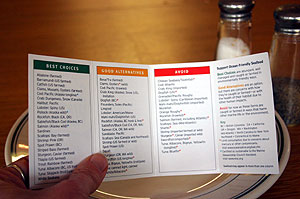 Last summer, while visiting family in Charlevoix, Michigan, I found myself with a crew of relatives at a stylish seafood restaurant on the lake. I was craving fresh seafood, so I pulled out my handy Seafood Watch Card (www.seafoodwatch.org) from the Monterey Bay Aquarium and prepared to order.
Last summer, while visiting family in Charlevoix, Michigan, I found myself with a crew of relatives at a stylish seafood restaurant on the lake. I was craving fresh seafood, so I pulled out my handy Seafood Watch Card (www.seafoodwatch.org) from the Monterey Bay Aquarium and prepared to order.
"What’s that? What are you doing?" asked a nervous looking anonymous parent figure.
"People outside of California don’t know about such things. You will embarrass our poor waiter."
Instead of backing down, I tried to educate. I told Anonymous Parent Figure that Seafood Watch Cards are the greatest things since sliced tofu when it comes to choosing sustainable seafood. The guides are pocket sized and fit in your wallet. They have three columns: The green column offers "best choices", listing fish that are abundant, well managed and caught or farmed in environmentally friendly ways. The yellow column offers "good alternatives", fish that may or may not be well farmed or caught. The red column states "avoid" and lists fish that are currently farmed or caught in ways that are harmful to marine life and the marine environment. Fish with a red asterisk are of concern due to mercury. Fish with a blue asterisk are certified as sustainable to the Marine Stewardship Council standard (www.msc.org).
I told her that with salmon, you should aim for Alaska wild-caught because wild Pacific salmon are among the most intensely managed species in the world. Salmon fisheries in California, Oregon and Washington are also well managed. Farmed Salmon, however, can escape from their ocean pens and threaten the wild salmon by competing for food and spawning grounds, and spreading parasites and diseases.
